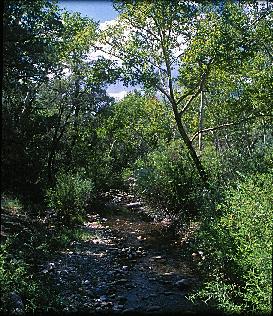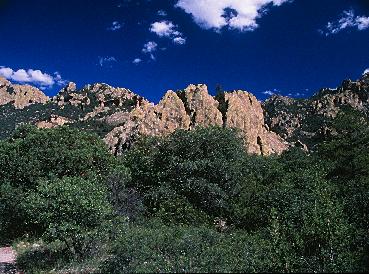
CHIRICAHUA
HABITATS
& ECOSYSTEMS

Semi-desert
Grassland:
Semi-desert grasslands
can be found on the lower slopes and valleys surrounding the
Chiricahuas at elevations between 3500 and 4500 feet. As the name
implies these areas are partially desert, but usually recieve 12 or
more inches of annual rainfall. Many species of both native and
introduced grasses can be found here including Bouteloua,
Bromus and Muhlenbergia, and plains lovegrass.
Mesquite, Acacias, soaptree yucca and other shrubs as well as
prickly pear and cholla cacti are found interspersed in these
habitats.

Chihuahuan Desert
Scrub:
This habitat is found in
isolated areas on the lower slopes and desert valleys between 3500
and 4000 feet in elevation. These areas usually recieve between 10-
l2 inches of yearly rainfall. Chihuahuan desert scrub is
characterized by the presence of small shrubs and having "indicator
plants" such as tarbush, creosotebush, Chihuahuan whitethorn acacia
and sandpaperbush. Some grasses are also found here along with a
number of species of smaller cactus species including prickly pears,
chollas, barrel and hedgehog cactus. Soaptree yuccas are also found
scattered over the terrain. On rocky hillsides and slopes Agaves or
century plants can be found. These areas have hot summers and cool to
cold winters with some occasional snow.



Riparian
Woodland:
Riparian Woodland is
found in narrow bands along river courses and along streams with
permanent or semi-permanent surface water. Riparian areas can be
found in lower elevation desert areas and extending to higher
elevations in canyon bottoms. Riparian areas are characterized by
lush vegetation and large trees. This vegetation includes Arizona
sycamore and walnut, cottonwoods, alder, maples, seep willow, desert
willow, catclaw and mesquite and some Oaks and Apache pine and
Arizona cypress at higher elevations. Because of the wide diversity
and abundance of water, Riparian areas are critical habitat for a
wide diversity of wildlife.


Madrean Evergreen
Woodland:
This habitat is charcterized by large
evergreen trees, most noticeably by the presence of a number of oak
species along with alligator and one-seed junipers and Mexican pinyon
pine. Intersperced in these areas are a number of grass species and
some cacti and yuccas and an occasional Agave. This habitat is found
at elevations between 5,000 and 7,000 feet but sometimes can extend
to higher elevations on south facing slopes. This area has cold but
mild winters with occasional snow and warm, wet summers during the
monsoon season.


Madrean Evergreen
Forest:
This Habitat is typically found between
elevations of 6000 and 8000 feet and is characterized by stands of
pines, including ponerosa, and Arizona white pine interspersed with
an occasional Gambel's oak. and Douglas fir. There are often large
open areas (parks) that form meadows of grasses and in the summer
months many kinds of wildflowers. Much of this forest in the
Chiricahuas is old growth stands of pine and is critical habitat for
goshawks and the Mexican spotted owl. Cold winters with sometimes 2-3
feet of snow are the norm for the winter, with the summers being
pleasantly cool with daytime temperatures in the mid 70's, but
cooling down to the low 50's to 60's at night. During the summer
monsoon season as much as two-thirds of the annual rainfall can
fall.

Montane
Mixed-Conifer Forest:
This forest habitat is
generally found between 8000 and 10,000 feet and is a lush and
diverse habitat. Ponderosa and Arizona white pines, Douglas fir,
white fir, blue spruce and quaking aspens making up the overstory
with various shrubs and grasses and braken ferns comprizing the
understory. Annual rainfall for this habitat ranges between 25-30
inches with snow in the winter and heavy monsoonal rains during the
summer.
 MILLENNIUM
SPRING VIDEO
MILLENNIUM
SPRING VIDEO
BACK
TO THE CHIRICAHUA WEB PAGE
Copyright 1998-2003
Charles Rau
All images and text
on these pages are under the copyright of Charles S. Rau and CSR
Nature Photography, none of the images or text may be copied, reproduced,
downloaded or used without the express written permission of Charles
S. Rau